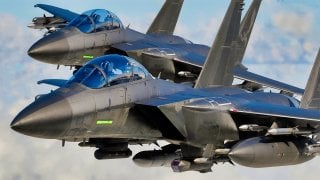The F-15EX Eagle II Fighter Has One Big Question to Answer
The F-15EX Eagle II, an advanced iteration of the McDonnell Douglas F-15E Strike Eagle, is designed to complement the U.S. Air Force's fleet by undertaking a variety of critical roles, including air superiority, homeland defense, and close-air support missions.
Summary: The F-15EX Eagle II, an advanced iteration of the McDonnell Douglas F-15E Strike Eagle, is designed to complement the U.S. Air Force's fleet by undertaking a variety of critical roles, including air superiority, homeland defense, and close-air support missions.
-Noted for its non-stealth capabilities, the F-15EX remains a formidable force in the air with enhanced armaments, avionics, and electronic warfare systems. Capable of reaching speeds of Mach 2.25 and equipped with advanced pulse-Doppler radar, the Eagle II can carry an impressive 13.6 tons of weapons, making it a highly versatile and powerful aircraft.
-Its integration of modern technology such as the Eagle Passive Active Warning Survivability System (EPAWSS) and a robust mission computer enhances its operational effectiveness, ensuring its relevancy on modern battlefields despite the prevalence of stealth-focused designs in contemporary air combat scenarios.
The F-15EX Has No Stealth: Does That Mean It Can't Fight (A Question That Must Be Answered)
The F-15EX is a powerhouse of a fighter. It has already broken records and is by far the heaviest-equipped air superiority jet in service.
Derived from the McDonnell Douglas F-15E Strike Eagle, the Eagle II is designed to supplement newer fighters in air superiority missions by carrying out homeland and air base defense, deploying standoff weapons in support of stealth fighters, and enforcing no-fly zones against limited air defenses.
Like the F/A-18E/F Super Hornet, the latest iteration of the legendary Cold War fighter is not undetectable in the skies. But while these airframes don’t possess the stealth qualities carried by their F-22 Raptor and F-35 Lightning II counterparts, they are still relevant and lethal fighters.
The F-15EX Eagle II: Specs & Capabilities
The Eagle II program was approved under the National Defense Authorization Act for the 2020 fiscal year, signed in 2019. Boeing was awarded a $1.2 billion contract to produce the first order of F-15EX jets the same year.
The new Eagle variant is fast and agile. It can reach Mach 2.25 and cover a range over 1,900 miles. Two General Electric F100-PW-229 turbofans with afterburners power the fighter, each able to produce 29,000 pounds of thrust.

Of all the F-15EX’s capabilities, its armaments are perhaps the most significant. Fox News first reported last year that the F-15EX can carry up to a dozen air-to-air missiles, which is double the typical number of its predecessor. This bomb truck of a plane can carry 13.6 tons of weapons, more than any earlier Eagle variant.
To make the platform even more intriguing, the F-15EX is less costly and more capable than older versions of the Lightning II. Some of the missile systems the platform can carry include the AIM-9 Sidewinder heat-seeking air-to-air missile and the AIM-120 advanced medium-range air-to-air, beyond-visual-range, radar-homing missile. The F-15EX could also function as a close-air support platform, carrying 24 air-to-ground munitions ranging from cruise missiles and stand-off weapons to conventional bombs and smart munitions.
F-15EX Eagle II: What About Countermeasures and Avionics?
According to Air Force Magazine, lethal weaponry won’t be the latest Eagle’s only asset: "The new airplanes would have a substantially more powerful mission computer, new cockpit displays, a digital backbone, and the Eagle Passive Active Warning Survivability System (EPAWSS) -- an electronic warfare and threat identification system."
The Eagle II’s pulse-Doppler radar system can detect all targets without being disoriented by ground clutter. Additionally, it can monitor and track other aircraft at distances beyond visual range. These capabilities, coupled with the Eagle’s payload and top-of-the-line early warning system, make the platform a dangerous force in the skies.
Unlike the F-35, the Eagle has been battle-tested many times over. It may not possess stealth, but its proven combat record would be an asset if a great power war erupts in the near future.
About the Author: Maya Carlin
Maya Carlin, National Security Writer with The National Interest, is an analyst with the Center for Security Policy and a former Anna Sobol Levy Fellow at IDC Herzliya in Israel. She has by-lines in many publications, including The National Interest, Jerusalem Post, and Times of Israel. You can follow her on Twitter: @MayaCarlin.
Image Credit: U.S. Air Force.


